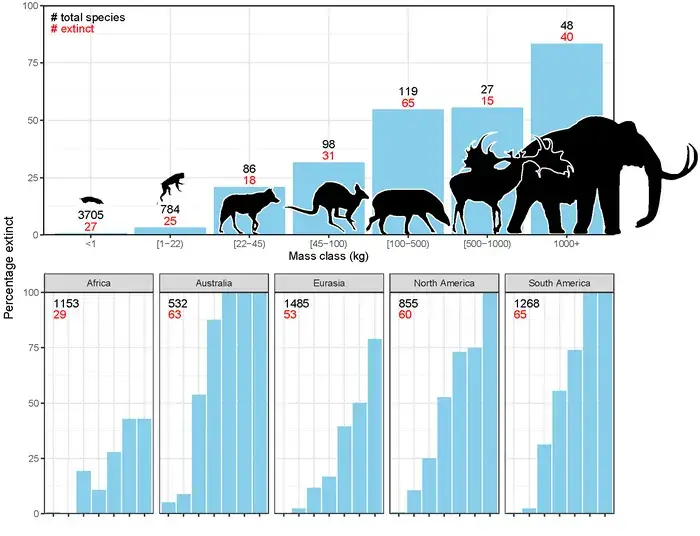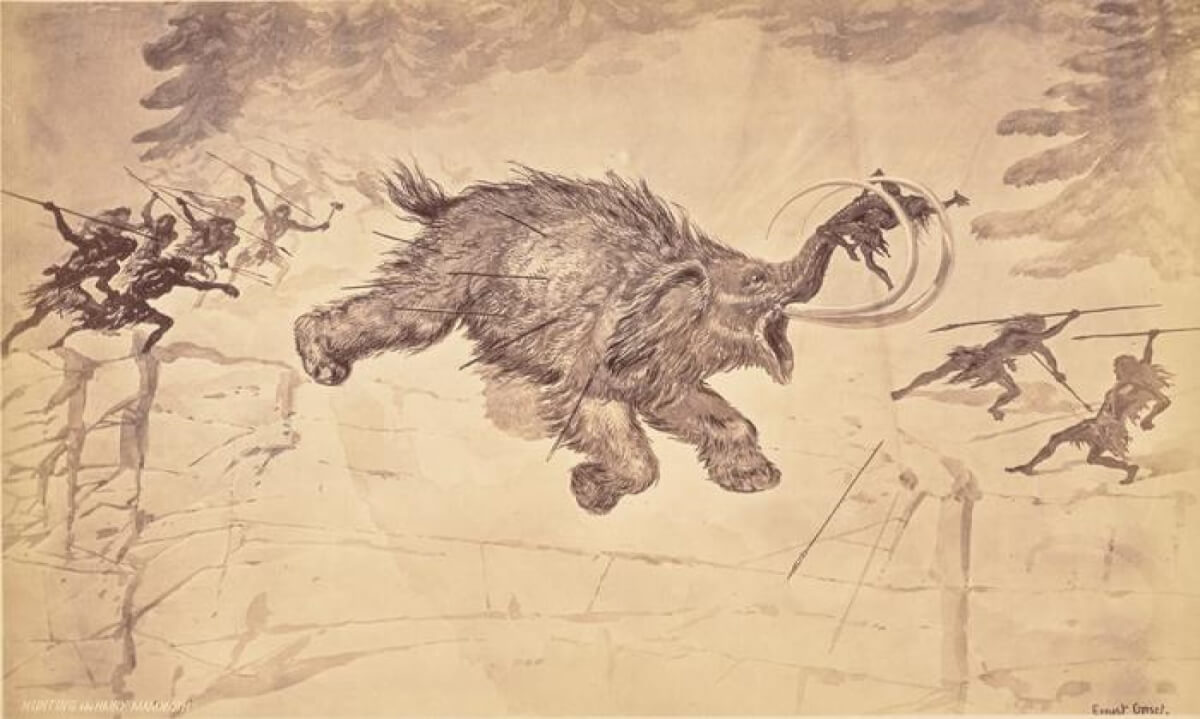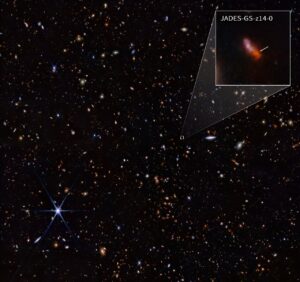Prehistoric people hunted woolly mammoth. A growing body of research suggests that this species – and at least 46 other megaherbivore species – have been driven to extinction by humans. (CREDIT: Engraving by Ernest Griese, photographed by William Henry Jackson. Courtesy of Getty’s Open Content Program)
AARHUS, Denmark — Imagine a world where elephants roam Europe, giant ground sloths roam the Americas, and armadillos the size of cars roam the South American grasslands. This wasn’t some fantasy realm from a Hollywood movie—this was Earth just 50,000 years ago. But then something happened. These megafauna—animals weighing more than 100 pounds—began to disappear. By 10,000 years, most had disappeared forever.
What caused this mass extinction that changed life on our planet? It’s a question that has puzzled scientists for more than 200 years. Now, an international team of researchers has carried out a comprehensive review of the evidence, concluding that prehistoric humans were probably the main culprits in the fall of the earth’s giants.
The study, led by scientists from the Danish National Research Foundation’s Center for Ecological Dynamics in a New Biosphere (ECONOVO) at Aarhus University, analyzed megafauna extinction patterns across continents and time periods. They found that large animals began to disappear shortly after humans arrived in new regions, with extinction rates highest where humans were most recent.
“The large and highly selective loss of megafauna over the past 50,000 years is unique to the past 66 million years. Previous periods of climate change have not led to large, selective extinctions, which argues against a major role for climate in the extinction of megafauna,” Professor Jens-Christian Svenning, lead author of the study, said in a statement.
The researchers point out that climate change, long considered a potential cause of the extinction, does not adequately explain the observed patterns. Although the Late Pleistocene epoch saw significant climate changes, they were no more extreme than previous glacial cycles that did not lead to mass extinctions.
“Another important pattern that argues against a role for climate is that recent megafauna extinctions affect both climatically stable and unstable areas equally,” Svenning adds.
Furthermore, megafauna losses are highly selective, mostly affecting only the largest species. Smaller animals, plants and marine life are largely unaffected. This variation in size is consistent with what we would expect from human hunting pressure, not climate change.
The study revealed that at least 161 species of mammals were driven to extinction during this period, based on the remains found so far. The largest animals were hit hardest — land-dwelling herbivores weighing more than a ton, known as megaherbivores. Fifty thousand years ago there were 57 species of megaherbivores. Today, only 11 remain, and even those survivors are experiencing drastic population declines.


Interestingly, regions where humans had a longer evolutionary history with large animals saw less severe extinction events. In Africa and parts of Asia, where hominins have been present for millions of years, fewer species of megafauna have gone extinct than in the Americas and Australia. This suggests that animals in Africa and Asia may have evolved behaviors to avoid human predators over time. Researchers have found evidence of human hunting prowess in the archaeological record.
“Early modern humans were efficient hunters of even the largest animal species and apparently had the ability to reduce populations of large animals,” notes Svenning. “These large animals were and are particularly vulnerable to overexploitation because they have long gestation periods, produce very few offspring at a time, and take many years to reach sexual maturity.”
The loss of these ecosystem giants had profound impacts that still shape our world today. Large herbivores such as mammoths and ground sloths played a crucial role in maintaining open habitats and dispersing nutrients across the landscape. Their disappearance probably contributed to the spread of forests and changes in fire regimes in many regions.
“Species have gone extinct on all continents except Antarctica and in all types of ecosystems, from tropical forests and savannas to Mediterranean and temperate forests and steppes to arctic ecosystems. Many of the extinct species could thrive in different types of environments. Therefore, their extinction cannot be explained by climate changes causing the extinction of a specific type of ecosystem, such as the mammoth steppe – which also harbored only a few species of megafauna,” emphasizes Svenning.
The authors argue that understanding this extinction event is critical as we face a biodiversity crisis today. By recognizing the long history of humans impacting animal populations, we can better inform conservation efforts. They even suggest “wildlife restoration,” the reintroduction of large animals to restore lost ecological functions, as a potential conservation strategy.
“Our results highlight the need for active conservation and restoration efforts.” By reintroducing large mammals, we can help restore the ecological balance and support the biodiversity that has developed in megafauna-rich ecosystems,” concludes Svenning.
The study was published in the journal Cambridge Prisms: Extinction.
Methodology
The researchers conducted an extensive literature review, examining evidence from paleontology, archaeology, genetics, and ecology. They analyzed megafauna extinction patterns across continents, time periods and body size classes. The team also evaluated various hypotheses for the extinction, including climate change and human impacts, against the observed patterns. Their review covers several research areas, including studies of the timing of species extinctions, animal dietary preferences, climate and habitat requirements, genetic estimates of past population size, and evidence of hunting by humans.
Results
The study found that the extinction of megafauna was global in scope but varied in intensity across regions. They were strongly biased towards the largest species and temporally associated with the arrival of man in new areas. The extinction was not well explained by climate change alone. The researchers note that at least 161 species of mammals were driven to extinction during this period, with land-dwelling herbivores weighing more than a ton (megaherbivores) being the hardest hit.
Limits
Among the possible limitations of this study is that the fossil record is incomplete, especially for smaller species, which may change our understanding of extinction patterns. The dating of human extinction and arrival events can be imprecise, making it challenging to establish precise temporal relationships. Furthermore, the complex interactions between humans, climate, and ecosystems are difficult to fully disentangle, especially over such long time scales.
Discussion and takeaway
The researchers conclude that human hunting and ecosystem modification were likely the main drivers of the megafauna extinction at the end of the Quaternary. They argue that this event marks an early example of human-driven environmental change on a global scale. The study highlights that humans have shaped ecosystems for tens of thousands of years and that large animals are particularly vulnerable to human impact. The loss of megafauna had cascading effects on landscapes and ecosystems, altering plant structures, seed dispersal patterns, and nutrient cycling. The authors emphasize the importance of understanding past extinctions to inform contemporary conservation efforts. They suggest that restocking with large animals can help restore lost ecological functions and maintain biodiversity in ecosystems that evolved with megafauna.



